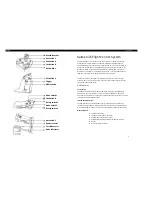
L-DALI User Manual
178
LOYTEC
Version 5.2
LOYTEC electronics GmbH
select on the desired favorites and click the detach button
. On linked favorites you may
click on the button
, which jumps to the linked data point in the data point list.
7.7.8 Managing Property Relations
Property relations can be linked to data points in various user dialogs (e.g. alarm condition
dialog). For editing links of property relations for a large number of data points, the
Manage Relations
tab in the property view area of the data point manager provides a fast
solution. The data point tree is replicated in that tab as shown in Figure 165. Select a folder
and optionally click on the button
to include property relations of data points in sub-
folders. Enter a filter expression to
Filter
, which applies to both the data point name and
relation type. For example, enter ‘feedback’ to display all feedback value property relations.
Figure 165: Manage relations tab.
To link property relations to other data points using the manage relations tab, navigate to
the desired folder in the main folder tree of the data point manager and select the data point
to be linked. Drag the data point onto the
Is related To
column. For detaching links, use
multi-select on the desired property relations and click the detach button
. On linked
property relations you may click on the button
, which jumps to the linked data point in
the data point list.
7.7.9 CEA-709 Properties
Apart from the common data point properties discussed in Section 7.7.3 the data points of
the CEA-709 technology have additional properties. Depending on whether a NV is local or
external (remote), the properties may vary.
NV Allocation
: This property defines how a data point shall be allocated on the device.
Choices are “Static NV”, “Dynamic NV”, and “External NV”. If the allocation type
cannot be changed, this property is locked.
SNVT
: This property defines the SNVT of the NV, e.g., “lux (79)”.
Invalid Value
: This property defines the “invalid value” for the NV. If set, this specific
value will be interpreted as “invalid” in the data point. If known by the SNVT, the
invalid value is filled in. Otherwise, the user can specify an invalid value.
CEA-709 Mapping Information
: This information is derived from the SNVT. It
defines how the NV contents are mapped to the data point.
NV Scaling A, B, C
: These are the scaling factors known from the SNVT table. The
scaling factors are applied to translate a raw NV value into the scalar representation of
the data point.
Data Type
: This is the basic NV data type. This is usually filled in from the SNVT
definition.
Local NV Member Index
: This property specifies the NV member index within a
given functional block. This must be a unique index in the functional block, which
identifies the NV after other NVs have been added or removed from the interface.
















































